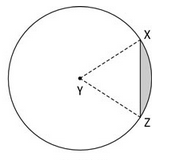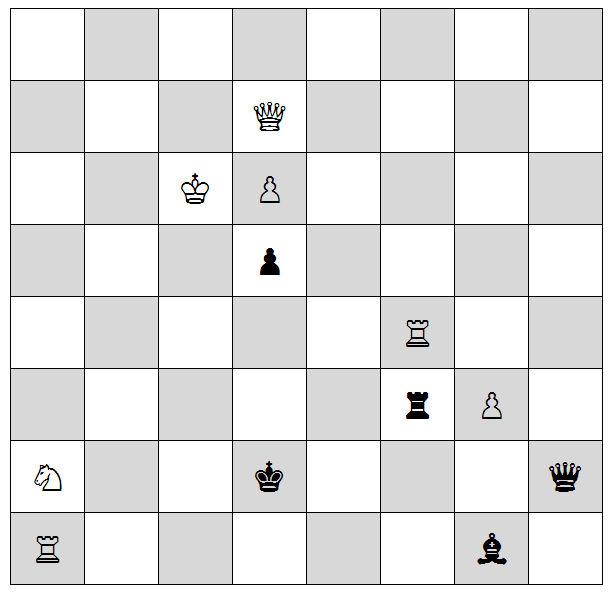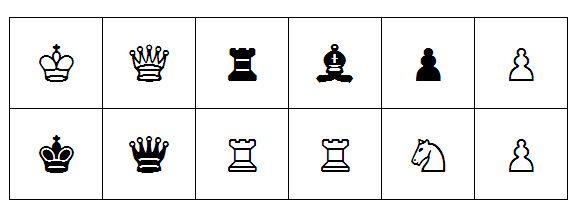-
Posts
433 -
Joined
-
Last visited
-
Days Won
15
Content Type
Profiles
Forums
Events
Gallery
Blogs
Posts posted by rocdocmac
-
-
Spoiler
<=4, 6, 8, 9, 11, 13, 16, 18 and 23
-
Spoiler
18 sausages uncut
12 sausages bundled together and a single 1/3 cut off (or 12 sausages with 1/3 cut off each individually) giving 24 pieces.
-
Spoiler
Hint: Place "1." in front of each term.
-
Which character should replace the question mark?
E I S H ?
-
Does this question mean finding a function where the arc length (XZ in the figure below) is the same as the area of the segment (shaded), notwithstanding the fact that arc length is in units and segment area in squared units?

-
Spoiler
Captain Ed has a good point. However ...
Species is a unit of biological classification, but the singular and plural are the same.
Specie is money held in coins rather than notes (i.e. a different word, but a plural form).
Are we looking for two different words, one of which is only singular (with the "s") and the other only plural (without the "s")?
I suppose the ending "ss" for singular and "s" for plural with the same stem is not what Bonanova has in mind. There are too many possibilities!
-
Spoiler
brass - s = bras
Playing with singulars and plurals I arrived at these facts ,,,
If the plural of mouse is mice and that of louse is lice, then the plural of house must be hice and the singular of rice must be rouse.
-
Apology ... last term should read 2765, not 3765!
Thus ... 4422, 4142, 3797, 3480, 3205, 2968, 2765, ?
-
What comes next in this sequence?
4422, 4142, 3797, 3480, 3205, 2968, 3765, ?
-
-
Thalia, what would you get if I change clue 4 to ...
 ?
Spoiler
?
SpoilerYour solution is certainly a valid one and you'll get your kudos due! I should have changed clue 4 as given above to force a unique solution!
-
Yes, Ed is correct.
-
-
@ Thalia ...
12) Black Q in her own column is correct.
"Adjacent" means any of the 8 surrounding squares.
One solution!
SpoilerIncorrect answer
-
-
There are two white rooks ... one of them is on the edge, and has nothing south of it.
-
-
3) Hollow victory is to Pyrrhic as hollow village is to [x]?
Spoileror potyomkin (if the Russian pronunctiation is considered)
4) Universe is to cosmo- as universal laws is to [x]?
Spoilercosmonomo-
-
Thalia is spot-on ... Well done!
[Sorry folks for duplication of the OP after initially posting as "Alchemy". It happened during the time that questions could not be read on the site]
-
This is a pretty easy fun exercise…
Suppose you have 24 “alchemical substances". Could you group each of them according to its type and color?
Rules:
(1) There are four types of substance only: crystal, dust, leaf, liquid
(2) There can’t be two substances that have the same type and color
(3) If two substances of primary color (blue, red, yellow) are mixed, you usually obtain a substance in which the color is the result of the fusion of the original substances
(4) The substances of secondary colors (green, orange, purple) can’t be mixed with other substances
Clues:
1. Basic acid
Used as a refreshing beverage extracted from amber feathers, from which can also be extracted a red powder you can find on the list. You can recognize that the color of the basic acid is exactly the same as that of the amber feathers, minus the red.
2. AntirubyResembles the anti-emerald in every aspect, but is of opposite color.
3. Anti-emeraldResembles the antiruby in every aspect, but is of opposite color.
4. Solid heatObtained by solidifying some sweet sulfur, from which it takes the color. The crystals of solid heat can sometimes grow crocodile tears which, unlike the solid heat, have the typical color of plants.
5. Vampire heartTypical crystals obtained by injecting drops of essence of sadness inside a crystal of anti-emerald. Clearly the color is derived by the fusion of the two substances. It takes its name from the fact that it resembles, in form and color, the drained heart of a vampire.
6. Baleful destinyThis is a potentially lethal substance obtained by mixing some tongue stingy and some essence of sadness. It’s of the same type as the latter, but its color is derived from the mixture of both.
7. Essence of sadnessA rare substance of a bluish color.
8. Neverthen leavesVery rare and mostly used in the production of green wine with which they don’t have the same color.
9. Pulverised leavesIt’s a substance useful as a base for many compounds, and obtained from the crushing of crocodile tears with which they share the color. .
10. Fragments of memoryA non-expert could easily confuse them for envy drops, given that they’re identical in the type of substance. It’s the color that makes the difference. Fragments of memory more closely resemble the color of the stardust. It can be used as a catalyst in some alchemical reactions.
11. MoonflowerIn the shadow of the moon many beautiful arcane flowers grow. The purple leaves, called moonflowers, follow the phases of the moon. These leaves are usually used as catalysts.
12. Envy dropsLittle crystals sharing part of their name with envy petals only because of their color. The type is completely different.
13. Crocodile tearsA mysterious substance growing spontaneously on a crystal present in the list. From crocodile tears it is possible to extract another substance, also listed here.
14. Faceless mandrakeThis is obtained by removing the blue from moonflowers through complex manipulation. Aside from that, the fearless mandrake has no catalytic properties, although being of the same type.
15. Tooth doughOne needs to crush antiruby to obtain this. Two powders will be produced – the first is blue, but not the same blue powder as listed somewhere here. The other is tooth dough.
16. Envy petalsThe drained leaves of the envy plant. It’s very easy for a beginner to make a mistake: envy petals are never blue!
17. Amber feathersThey’re wrongly considered to be linked to sweet sulfur because of their identical color. It’s possible to extract two powders from amber feathers – only one of these is listed. Using a pot, one can extract a drink you can find in the list and a useless liquid. From that, we can conclude that amber feathers never appear in liquid or powder form.
18. StardustWrongly considered a product of neverthen leaves because of their identical color.
19. Tongue stingySubstance for refined palates, obtained by crushing some amber feathers. It also comes out a yellow substance which is not listed. Its color is similar to that of the amber feathers without the yellow.
20. Love bloodOften used in love potions and is similar to blood in type and color.
21. Dragon bloodDoes not look like blood, either in type or color. It has the opposite color of tooth dough.
22. Salted sunA powder that is perfect for food. Obtained by crushing an anti-emerald and adding a yellow dye.
23. Green wineObtained from the fermentation of neverthen leaves and envy petals. The color is derived by the sum of the color of the two substances.
24. Sweet sulfurThe substance formed by mixing water and salted sun. The resulting compound is similar in consistency to the green wine and in color to the salted sun
-
I meant coming of age being 21, but 18 gives the same result. Well done T!
-
Sorry!
... coming of age ...
-
Two of the ages of three brothers together equal the third age.
Some years later, the sum of two of the three ages is double the remaining age.
One of the brothers is coming to age today.
The number of years since the first occasion is currently two-thirds of the sum of their ages at the time of the first occurrence.
What ages do the other two brothers have today?
-
Spoiler
tea tray (?)
Spoiler... or tea ball (?)





.jpg.aa5b9df06a4a8d18409ee58bfce49023.jpg)
.jpg.ede6ee4b8be28e7ce4b0a7a90677b7c4.jpg)


Interjection sequence
in New Logic/Math Puzzles
Posted
Need a hint Ed?
Plainglazed, there happens to be another sequence similar to the one posted above ...
T M O ? 0